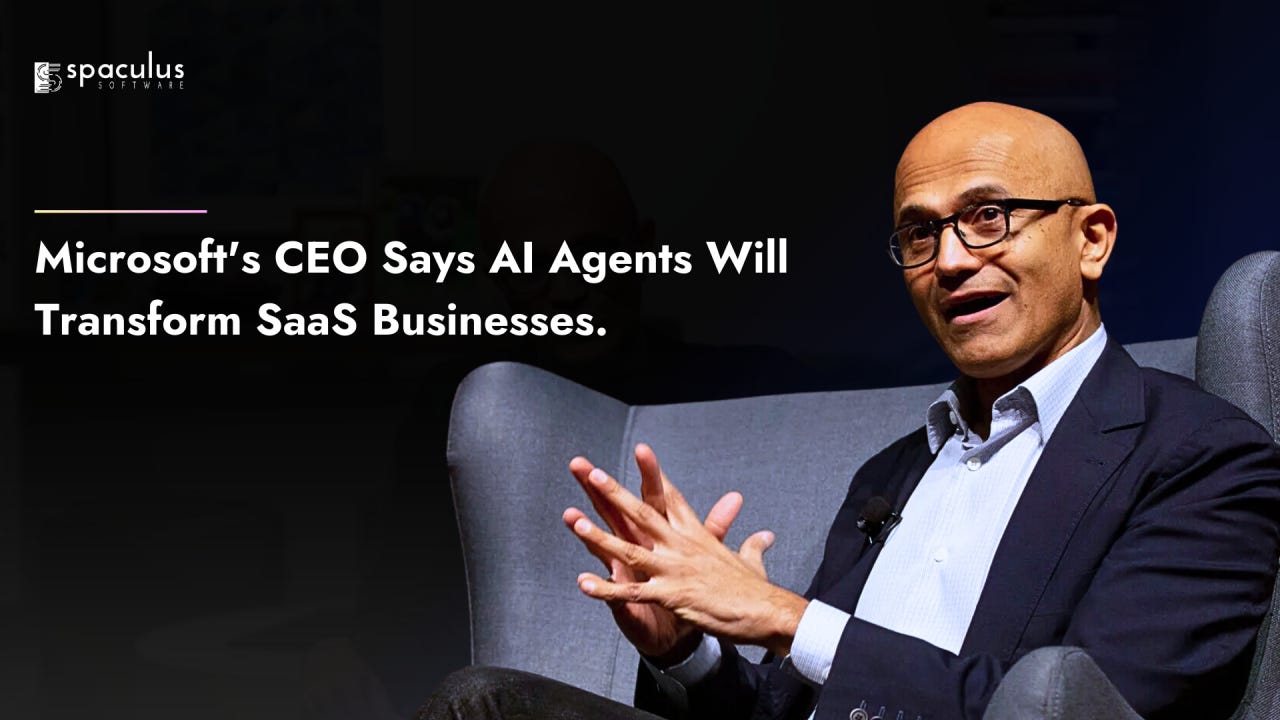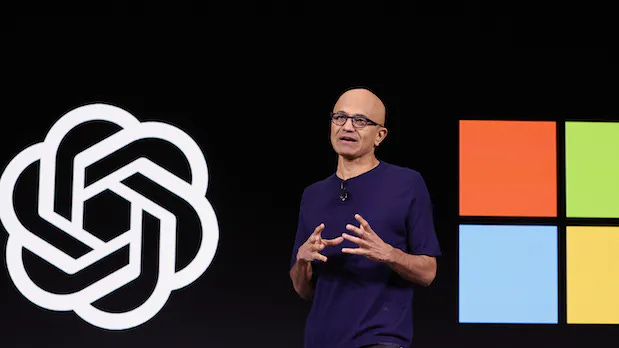AI: Microsoft leaning into AI shifts into the Enterprise. RTZ #742
...not business as usual selling AI into businesses
As the software industry adjusts to selling AI products and services to enterprises, especially around AI Reasoning and Agents, the underlying pricing models are changing as well. Part of this is driven by the variable cost nature of AI software, where higher AI inference use means higher costs for the provider.
We’ve seen this with companies like OpenAI, which has seen unprecedented fast enterprise and consumer growth of their AI chatgpt plus services. Microsoft CEO Satya Nadella is showing how much out of the company’s comfort zone the organization has to shift to meet the AI challenges and opportunity.
Now OpenAI’s partner Microsoft is also evolving its organization and pricing around AI product evolution to Agents and beyond.
The Information goes indepth on this shift in “Microsoft Bets On Agents to Fuel Next Chapter of AI Growth”:
“In March, at a Microsoft all-hands meeting, one of the company’s newest executives, Jay Parikh, laid out a rough vision for Microsoft’s path forward in artificial intelligence.”
“AI models made by OpenAI and others were quickly becoming commoditized by more efficient models from DeepSeek and Microsoft’s own research arm that performed nearly as well for a fraction of the cost, Parikh said, sitting alongside chief executive officer Satya Nadella and chief technology officer Kevin Scott. That meant it would soon become easier for companies to build their own AI applications—and that Microsoft could cash in on that growing market by redoubling its efforts to sell them tools for doing so, said Parikh.”
The company is focused on AI Agents around AI platforms:
“In recent months, Nadella has made similar comments in staff meetings, telling employees that Microsoft needs to focus on “platform, platform, platform,” according to someone who heard the remarks. The refrain harked back to a speech by Nadella’s predecessor, former CEO Steve Ballmer, from the late 90s, in which he uttered the memorable chant: “developers, developers, developers.”
“The comments from Nadella and Parikh reflect a subtle but important shift in AI strategy at Microsoft. No big tech company has benefited more from the frenzy around AI than Microsoft, whose $3.44 trillion market capitalization makes it the world’s first or second most valuable company depending on the week (Nvidia took the crown on Tuesday). So far, the bulk of the company’s AI revenue has come through its relationship with OpenAI, which trains and runs its models on Microsoft’s Azure cloud computing service to support applications like ChatGPT.”
However, Microsoft’s future in AI is different from its longtime partner OpenAI:
“But a future in which AI models become commodities could make Microsoft’s revenue from powering them less certain. Compounding that uncertainty is the fact that OpenAI has also signaled it eventually plans to spend more on its own data centers than it will with Microsoft. A more lucrative opportunity for Microsoft, its executives believe, could come from how those cheaper models democratize the development of AI applications.”
Thus the shift into AI Agents, Level 3 in the AGI roadmap chart above:
“They are particularly bullish on a new category of AI applications called agents, which will be able to carry out tasks such as maintaining a spreadsheet to keep track of unpaid bills or patching websites after outages with minimal human oversight. Agents are all the rage throughout the tech industry, not just at Microsoft, with other enterprise giants like Salesforce, ServiceNow and SAP rushing similar products to market. The growth of agents could take off with cheaper AI costs, leading to the rise of what some executives call the agentic web, in which most of the world’s computing power is taken up by autonomous AI software.”
And Microsoft has also decided to lean into open source LLMAIs:
“For Microsoft, taking advantage of the shift towards agents means making new, inexpensive models available on Azure as an alternative to larger models, embracing open source protocols that make it possible to build agents and launching new products that let customers set up their own custom-built agents.”
“The goal is to build the new stack that allows anyone to build AI-driven applications and agents, and to orchestrate them,” Parikh said at an event connected to Microsoft’s annual Build conference in May, where he echoed many of the themes of his remarks at the March all-hands meeting.”
Thus the new changes driven by executives from outside the company with fresh perspectives:
“At the center of the shift is Parikh, a former Meta executive who joined the company in October in an unnamed role. In January, he became the head of a newly formed unit dubbed CoreAI that unified groups from across the company, including the company’s developer platform GitHub; its internal developer division, known as DevDiv; and several teams that previously reported to Azure head Scott Guthrie and focused on running AI models on cloud servers.”
“Parikh now oversees more than 10,000 staffers at Microsoft, which employs a total of more than 220,000 people.”
“(After this story was published, Nadella on Wednesday announced another reorganization to staff focused on agents, consolidating executives running LinkedIn, Office 365 and business applications under executive vice president Rajesh Jha. Those groups will aim to sell out-of-the box agent applications to customers, while Parikh’s unit focuses on getting companies to build their own agents on Azure, according to a Microsoft employee familiar with the plans.)”
This also means fresh look at pricing models that have been standard for a while in enterprise SaaS models:
“One of Parikh’s challenges will be to change how Microsoft makes money from customers that use its AI products to ensure stronger growth for the business. Currently, most of those customers pay flat monthly rates for its AI products based on the number of people who use them—known as seat-based pricing. In some cases though, the growth in spending by some of those Microsoft customers seems to have stalled.”
This could be a change as meaningful as the one from selling Office 375 with annual upgrades to perennial subscription contracts:
“The shift to agents could provideMicrosoft with a more reliable source of growth, since running them requires customers to pay for Azure cloud services based on consumption. Investors believe that approach will become the standard for charging for AI applications, replacing the seat-based pricing model.”
“There are going to be software companies that are able to embrace and adopt that, and there are going to be software companies that are going to find that highly disruptive to their models,” said Denny Fish, a Janus Henderson Investors portfolio manager who oversees two funds that hold a total of more than $800 million in Microsoft stock. “Microsoft’s ability to embrace that will be really important.”
“For their part, Microsoft executives are optimistic that their push into agents will present a bigger opportunity for how customers use AI.”
“Agents will scale by business size and business growth,” said corporate vice president of business applications Charles Lamanna. “There’s more opportunity there outside of the number of user licenses” as customers increasingly rely on agents to run their businesses more efficiently, he added.”
For a while, it will be a trial and error set of experiments in both camps:
“To be sure, Microsoft isn’t backing away from per-seat pricing for AI tools entirely. It continues to offer Copilot chatbots as $30-per-seat add-ons to its popular Office 365 productivity software for businesses. And Microsoft has included Copilot by default in the consumer version of Office while raising the per-seat cost across the board, boosting sales year over year as a result.”
The organizational changes as well are a marked shift in the Microsoft Way:
“By hiring the longtime Meta executive to a role directly reporting to himself, Nadella broke with a longstanding Microsoft practice of mostly appointing company insiders to its most senior ranks.”
“Nadella has increasingly broken that tradition in recent years, with the goal of bringing in fresh thinking to the company, according to someone who spoke with him recently. His belief was bolstered by his previous decisions to hire Amazon veteran Charlie Bell and former Google executive Mustafa Suleyman to oversee Microsoft’s cybersecurity and consumer AI businesses, respectively, although both executives have faced challenges in reshaping the teams they oversee.”
The approach has had its shares of ups and downs as the full article recounts.
But the story thus far highlights how flexible even established big tech players like Microsoft are going to have to be in this AI Tech Wave, to find their footing at Scale with AI sales in the Enterprise space. Stay tuned.
(NOTE: The discussions here are for information purposes only, and not meant as investment advice at any time. Thanks for joining us here)











